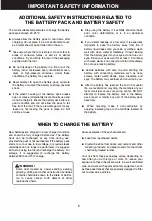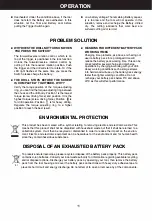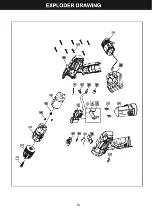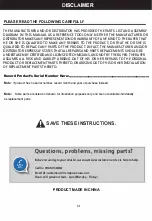
IMPORTANT SAFETY INFORMATION
ADDITIONAL SAFETY INSTRUCTIONS RELATED TO
THE BATTERY PACK AND BATTERY SAFETY
The most suitable temperatures to charge the battery
pack are between 20 -25
°
C.
■
Always allow the battery pack to cool down after
charging, do not place it in a hot environment such
as a metal shed or open trailer left in the sun.
■
Take care where the tool is stored. Do not store in
areas of corrosive fumes, or salt air or similar
conditions. Try and store the tool in the packaging
supplied with the tool.
■
Do not dispose of the battery in a fire or put the
battery into a microwave oven, conventional oven,
dryer, or high-pressure container. Under these
conditions, the battery may explode.
■
Never attempt to open the battery pack, puncture
the battery or subject the battery to strong physical
shock.
■
If the plastic housing of the battery pack breaks
open or cracks, immediately discontinue its use and
do not recharge it. Ensure the battery pack clip is in
good condition and will not allow the pack to fall
free from the tool. If the clip is damaged or for any
reason is not locking the pack in place Do Not
■
Stop using the battery if it exhibits abnormal heat,
odor, color, deformation, or is in an abnormal
condition.
■
If you detect leakage or a foul odor, it is especially
important to keep the battery away from fire. If
battery liquid leaks onto your skin or clothes, wash
well with clean water immediately. If liquid leaking
from the battery gets into your eyes, do not rub your
eyes. Rinse your eyes well (for at least 10 minutes)
with clean water, and consult a doctor immediately.
Do not use a leaking battery.
■
Handle batteries with care to avoid shorting the
battery with conducting materials, such as nails,
screws, metal watch bands, rings, bracelets, and
keys. The battery may overheat and could burn you.
■
After the battery has reached the end of its useful
life, we recommend recycling the materials at your
local municipal council recycling center. DO NOT
attempt to replace the battery cells in the battery
pack, repair or modify any part of the battery pack
assembly.
■
When recycling, make it non-conductive by
applying insulating tape to the terminals located on
the battery.
continue to use.
WHEN TO CHARGE THE BATTERY
New batteries are shipped in a low charged condition
and should be fully charged before Use. The battery
pack can be recharged at any time during use,
provided the pack is not overheated. If the battery pack
starts to cut out due to low voltage, or previous tasks
undertaken can no longer be performed, it is suggest
ed to stop using the tool and recharge the battery. For
storage, it is suggested to recharge the battery
between 50% and 75% charge.
,&WARNING!
Some dust created by power sanding, sawing,
grinding, drilling and other construction activities
contains chemicals known to the State of Califor
nia to cause cancer, birth defects of other
reproductive harm.
Some examples of these chemicals are:
■
Lead from lead-based paints
■
Crystalline silica from bricks and cement and other
masonry products, and Arsenic and chromium from
chemically-treated lumber.
Your risk from these exposures varies, depending on
how often you do this type of work. To reduce your
exposure to these chemicals: work in a well-ventilated
area, and work with approved safety equipment, such
as those dust masks that are specially designed to filter
out microscopic particles.
5
Содержание 47519
Страница 13: ...12 ...

































